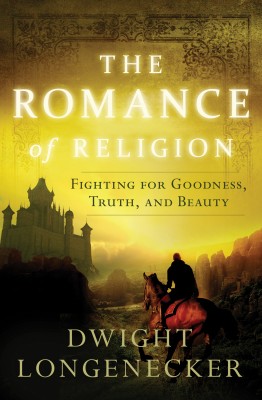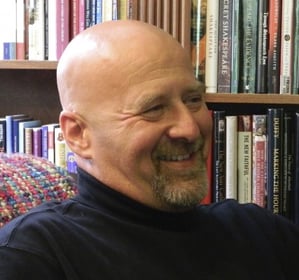 Today for Book Notes, I'm pleased to excerpt a portion of the wonderful new book The Romance of Religion: Fighting for Goodness, Truth, and Beauty by my fellow Patheos Catholic blogger, Fr. Dwight Longenecker.
Today for Book Notes, I'm pleased to excerpt a portion of the wonderful new book The Romance of Religion: Fighting for Goodness, Truth, and Beauty by my fellow Patheos Catholic blogger, Fr. Dwight Longenecker.
Father Longenecker has served as a parish priest, a chaplain at Kings College, Cambridge and a country parson on the Isle of Wight. Dwight has written sixteen books and countless articles for websites, magazines, and papers in the USA and Britain. His blog, Standing on My Head, has been voted one of the top religious blogs in the country. He holds a degree in theology from Oxford University and currently serves a local parish in Greenville, SC.
I hope this short excerpt will leave you with an appetite for more. Fr. Longenecker's writing is superb and this book opens an important conversation. LMH
Chapter Three: The Matrix and My Mickey Mouse Lunchbox
The Quest for Something More
At the age of six I rode to school in a big yellow school bus. As we lived in the country this gave me considerable time each day for the contemplation of metaphysical problems. A particular conundrum was caused by my Mickey Mouse lunchbox. I remember very clearly that my lunchbox was painted to look like a big yellow school bus like the very one I was sitting in.
On the outside of the lunchbox were printed various Disney characters cheerfully riding off to school. On this happy lunchbox was a most disturbing detail. At the door waiting to board this Disney-fied school bus stood Mickey Mouse himself. Mickey was waving with innocent enthusiasm, but the intriguing and somewhat sinister thing about Mickey is that he was holding a yellow school bus lunchbox that was identical to mine.
On the way to first grade this made me think. If I had a lunchbox with Mickey Mouse on it, and if Mickey held an identical lunchbox, did that mean on Mickey’s lunchbox there was another Mickey Mouse holding another identical lunchbox? I looked closely and sure enough, there on Mickey’s little lunchbox was another minute Mickey clutching another lunchbox just like mine.
Now what made my six year old head spin was the question, “Did that tiny Mickey also have a lunchbox on which was there yet another happy Mickey with an even tinier lunchbox with yet another minute Mickey happily going off to school on a yellow bus?” Logic demanded there to be ever more and ever more minute Mickeys on lunchbox after lunchbox ad infinitum. Was the everlasting succession of tiny Mickeys and lunch boxes there even though I could not see them?
There seemed to be worlds within worlds within worlds. Was the cosmos like this I wondered? Were there more worlds locked inside this one with even more locked in each one of them on and on forever? Was the cosmos one big onion or a Russian doll, with layer upon layer of reality--each one lying inside the next, each one more beautiful and intense than the one before? Did I hold in the form of my Mickey Mouse lunchbox a metaphor of eternity? Was this ordinary container for peanut butter sandwiches, a cookie, an apple and a thermos of juice a pointer to other worlds? Was my Mickey Mouse lunchbox not just an advertisement for Disneyland, but an advertisement for Wonderland and Neverland? Did I hold in my hands a magical transporter to another dimension? Were there dragons, elves, wizards and fairy godmothers inside? What if I opened it and found not a sandwich but a witch? What if that sandwich contained not Peter Pan peanut butter, but Peter Pan himself?
Unfortunately my first grade teacher did not discuss these matters in class. If she had the answers she wasn’t telling. She seemed more concerned with tiresome matters like keeping order, singing The Farmer in the Dell, and teaching us to spell. Nevertheless, the world of childhood is not lacking in similarly fascinating riddles. Indeed, I suspect far more contemplation of metaphysical problems takes place in the minds of six year olds than sixty year olds. Children are curious. They are fascinated by other worlds, the spiritual dimension, life after death, time and eternity. One of the reasons they like fairy tales is because through them they can play with their exciting playmates called good and evil, magic and mystery, time and eternity, destiny and death.
Myth, Metaphysics and The Matrix
The possibility of another unseen world running parallel to this one is the complex premise of the stylish movie The Matrix. The hero, Neo Anderson, is locked in a boring artificial world as an office drone when he hears the call to adventure. He is told that his ‘real’ world is in fact a computerized artifice. The really real world exists on a different plane altogether. He is challenged to go through the looking glass to the real world, then return to do battle in the artificial world for all that is beautiful, true and real. Neo’s wake up call makes him aware of the existence of the other world, and his quest is to give up everything for reality.
The modern fairy tale of The Matrix is as old as Jason’s quest for the fleece and Parsifal’s search for the Holy Grail. In the stories of every age the hero is a romantic character who is shaken from the slumber of his ordinary world and called to embark on a heroic quest. As I studied Mickey Mouse on my lunchbox and wondered if there was more, so the hero puzzles over the mundane details of ordinary life and tries to figure out the riddle. He traces in his ordinary world the signs of a larger, better life and the pattern of mystery and meaning that is far more tremendous than he could ever have imagined.
The mythologist Joseph Campbell studied the stories of cultures around the world and discovered that a pattern runs through them all. All the great stories are stories of romantic heroes. Legends, myths, folklore and fairy tales enchant us with the accounts of ordinary men and women who hear a call to adventure and leave everything to find some great treasure.
Their calling disturbs their peace. It upsets their comfortable little world. It whispers to them that their ordinary world is simply a portal into another realm. The call is an enchantment that reminds them that there is more, yet more, and that their ordinary world is cramped, narrow and dark. At first the hero refuses the call because he feels inadequate, frightened, confused or simply lazy. But then he meets a mentor—some wise older person, who affirms the validity of his call, encourages him to embark on the adventure. Once on the roller coaster of his adventure the hero encounters enemies and allies. He learns how to be a hero not by sitting at home thinking about it, but by taking a risk and setting out on the quest.
The hero embarks on a quest because he has asked a question. In fact, he has decided that the meaning of life is to ask a question, and the question is, “What is the meaning of life? Gradually it dawns on the hero that the answer to the question is not simply a formula or a phrase. It is not even a dictum or a doctrine. It is more than rules and regulations and rubrics. The answer to the question is to go on a quest.
Hollywood and The Holy Wood
In ancient times the heroic stories were told by wealthy and powerful wizards who lived on the holy mountain or the sacred grove. Today the heroic stories are told by wealthy and powerful wizards who live not in a holy wood, but in Hollywood. In ancient times the people sat in the dark around the flickering campfire to hear the mysterious adventures of the hero. Today we sit in the darkened cinema around the flickering lights of the film projector to share in the same forms of elemental heroic drama. Aristotle understood the mysterious workings of drama. He knew how we bond with the mythic hero. The ancient Greek, enthralled by the drama of gods and men were enchanted by the same principles that captivate us when we sit with a box of popcorn to yield ourselves to the magic of the latest blockbuster.
The scriptwriters, directors and actors all conspire together to get us to love the hero. The hero must always be an ordinary person because it is from the ordinary that we step into the extraordinary, and we step from the ordinary into the extraordinary in order to see that the extraordinary has been hidden in the ordinary all the time--just like it was in the mysterious matrix of my Mickey Mouse lunchbox.
As the hero goes on his quest he invariably stumbles and falls, and as he falls we fall with him and as we fall with him, we fall in love with in love with him. That is to say, we identify with him. We share his problems. He becomes our brother and our friend. When he makes a decision we make the decision with him, until at last we are drawn, by the drama into our own personal choice between good and evil, and as we do a bond between us is forged, and it is like the bond of love. We are united with the hero in a most mysterious and mystical way. We have become brothers in arms, or you could say, we have become brothers in charms.
For the story charms us. It enchants us. It casts a spell that transforms our way of seeing this world. Long ago the stories were told by the wizards and magicians because everyone knew the magical effect of the heroic tale was a part of some magic from before the dawn of time. So the stories, myths and movies enchant us like a fine romance. The reason falling in love is so intoxicating and dangerous is that we are falling, and when we are falling we are out of control, and we are out of control because we are out of ourselves.
That is to say, when we fall in love we come to believe in someone and something greater than ourselves. Suddenly we have something else to live for and life takes on a new dimension of reality. This is what happens when the hero asks his question and embarks on his quest. He moves outside himself. In that respect every heroic story is a romance, and the earliest form of the romance was not really a sentimental love story, but an adventure story of knights saving fair maidens from fearsome dragons. The earliest romances were tales of bravery courage and a holy quest.
The Religious Romantic
This is what the romance of religion is all about—it is about embarking on a quest for the pearl of great price, the secret treasure hidden in the field, the lost coin, the lost sheep or the lost child. To go on this adventure is to step into another dimension--not only in the next life, but in this life here and now. To go on this quest demands that we step out of our ordinary world into the world of adventure. To do this we must first catch the glimpse of the truth that there is another world to step into, then hear the call to step out of one world and into another.
The stories about parallel worlds in a multitude of fantasy movies, stories and fairy tales are only pointers to the fact that there really is an alternative to the desperately dull and deadly lives most of us lead. The reason the writers of the fantasy tales have the hero go to the other world through a mask or a mirror, a whirlwind, a wardrobe or a rabbit hole is because it is through the ordinary things of life that we connect with this other world. The connecting point is not through an esoteric or ecstatic experience, but through an everyday and ordinary occurrence.
The call might come to us at any time--through some great trauma or joy, or through the most ordinary and unexceptional event. The insight comes through a new way of seeing. Missouri is famously known as the ‘Show Me State’, and the man from Missouri is the classic skeptic. The problem with a skeptic is that he is antiseptic. Antiseptic kills bacteria, but it also kills beer, for beer requires bacteria. Similarly life requires risk, and the skeptic, like the antiseptic, kills everything he touches. The Man from Missouri says, “Show Me” but refuses to look. He says, “Seeing is Believing” but refuses to open his eyes.
The requirement for stepping through the whirlwind, the wardrobe, the mask or the mirror into another world, is the ability first of all to find the mask or the mirror, the wardrobe, the trapdoor, to find the red pill that transports you from the merely physical to the metaphysical. To discover this requires an understanding of the mechanics of metaphysics, and like the preparation for any adventure, this takes a dash of curiosity, a splash of study and a gasp of sudden, unexpected enlightenment.
Be sure to check out our Book Notes archive.
Copyright 2014 Lisa M. Hendey
About the Author

Lisa M. Hendey
Lisa M. Hendey is the founder of CatholicMom.com, a bestselling author and an international speaker. A frequent radio and television guest, Hendey travels internationally giving workshops on faith, family, and communications. Visit Lisa at LisaHendey.com, on her Substack at LisaHendey.Substack.com, or on social media @LisaHendey for information on her speaking schedule or to invite her to visit your group, parish, school or organization. Find Lisa’s books on her Amazon author page.




.png?width=1806&height=731&name=CatholicMom_hcfm_logo1_pos_871c_2728c%20(002).png)
Comments